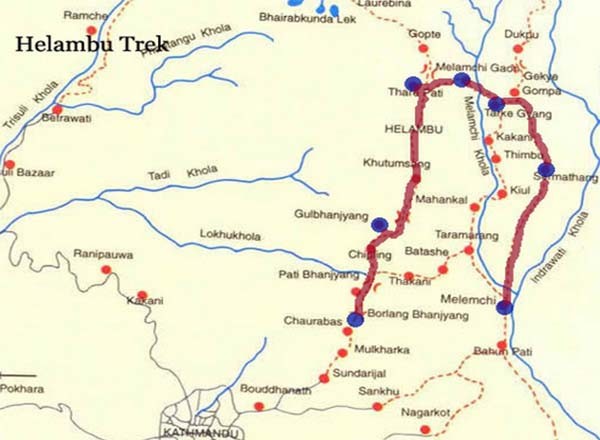Overview
Helambu valley trek offers a fascinating combination of natural beauty and cultural riches. The best thing about Helambu valley trekking is the lack of crowds, allowing you to commune with nature and really experience the local culture. This trip is specifically designed for those who doesnot have more time for the longer treks.
Outline Itinerary
Detailed Itinerary
Day 01: Kathmandu Arrival and hotel transfer
Our representative will take you from Airport and transfer to your hotel.
Day 02: Kathmandu Sightseeing (optional)/ Trekking preparation
Day 03: Kathmandu – Chisapani 2,300m - B/L/D
We are going to start the trekking part of this journey today. We drive for about 40 minutes to Sundarijal, the trek starting point. We set off the trail up towards Chisapani, a beautiful place that provides panoramic views of the mountains and natural surroundings. About five hours of uphill trek through forest and village finally takes us to Chisapani to stay overnight. We spend leisurely time around Chisapani once we reach there.
Day 04: Chisapani to Kutumsang 2,450m , B/L/D
The walk today is pretty much easier given its less involvement of steep ascent and descent. Although we have to walk some uphill and downhill trail in some places on the route to Kutumsang today, the trek can be considered as moderate in its difficulty level. As we traverse the trail we can enjoy the view of the mountains in Langtang range. The beautiful walk of the days ends when we reach Kutumsang where we can wander around and explore the place.
Day 05: Kutumsang to Thadepati 3,650m, B/L/D
About six hours of trekking journey takes us to Thadepati for overnight stay. The trail section brings some spectacular views and beautiful experience of trekking. We can enjoy marvelous views of the Himalayas from Yurin Danda and some natural wonders come along the trail today before we reach the destination.
Day 06: Thadepati to Tarke Ghyang 2,743m, B/L/D
The walk from Thadepati to Tarke Ghyang today is a wonderful exploration of Helambu region. The walk takes us to this beautiful Sherpa village of Tarke Ghyang via Melamchi Gaun in the region. We can explore monasteries and the village once we are in Tarke Ghyang. Tarke Ghyang is an incredible place to observe the mixture of culture and spirituality. We immerse in to the charm of both, culture and spirituality.
Day 07: Tarke Ghyang to Sermanthang 2,620m, B/L/D
Sermanthang is another village rich in culture and is full of natural wonders surrounding it. About five hours of walk takes us to Sermanthang. Along the trail, we pass through many other villages rich in Sherpa culture and inspiring simplicity of life. We also walk through some forested area along the trail before reaching Sermanthang for overnight stay.
Day 08: Sermanthang to Melamchi Pul Bazar and drive to Kathmandu, B/L
As the final day of walk in the Gosainkunda Helambu region, we trek to Melamchi Pul Bazar. We trek down past many villages with their traditional cultures. We will also walk through terraced fields that people do the farming on. Once we reach Melamchi Pul Bazar, we will stop for the lunch before setting off on a drive back to Kathmandu.
Day 09: A free day in Kathmandu for shopping and rest.
Day 10: Departure from Kathmandu - B
Our representative will drop to Kathmandu airport.
B: Breakfast, L: Lunch D: Dinner
Cost Details
Equipments Checklist
Clothing
Warm jacket or down jacket
Water and windproof jacket, poncho or umbrella
Long sleeved synthetic fleece
Thermal underwear
Hat, pair of gloves and scarf
Comfortable hiking trousers (loose fitting)
Shorts and trousers, or skirt
2 pairs of warm wool-blend socks
2 pairs of running socks or liner socks
Proper hiking boots
Running shoes and flip-flops
T-shirts
During winter season, additional clothings may include:
The outer jacket should be warm, down jacket is highly recommended during winter season
Bring a pair of warm winter trousers, in addition to the hiking trousers
Bring at least one windproof layer of clothes, helping to reduce any chill factor influence.
Snow gaitors
Trekking Gear
Pair of polarizing sun-glasses (to be comfortable and to avoid potential snow-blindness)
Backpack and backpack cover (against rain and dust)
Map of the trekking area
Head torch, or small torch, plus spare batteries
Sleeping bag and silk liner
Water bottles
Miscellaneous
Toiletries
A small light weight and quick drying towel
Bar of soap
Sunscreen (at least SPF +20)
Earplugs
Insect repellants (for lower elevations)
First aid kid
Water purification tables or a water filter
Some Diamox pills against potential altitude sickness (if going beyond 4,000 m elevations)
Toilet paper
Optional items
Camera, battery etc
Altimeter
Compass
Binoculars
Books/magazines
Trekking poles
GPS unit
Padlocks for guest house rooms and bags
Sewing/repair kit
Pocket knife
Candles (for lodges)
Dairy or notebook plus pencil/pen
Camping
Tent
Stove and fuel
Cooking, eating and drinking utensils
Sleeping mat
Food and water (for the very remote trekking areas)

